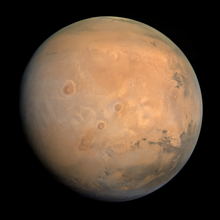
Mars
Fourth planet from the Sun / From Wikipedia, the free encyclopedia
Dear Wikiwand AI, let's keep it short by simply answering these key questions:
Can you list the top facts and stats about Mars?
Summarize this article for a 10 years old
Mars is the fourth planet and the furthest terrestrial planet from the Sun. The reddish color of its surface is due to finely grained iron(III) oxide dust in the soil, giving it the nickname "the Red Planet".[21][22] Mars's radius is second smallest among the planets in the Solar System at 3,389.5 km (2,106 mi). The Martian dichotomy is visible on the surface: on average, the terrain on Mars's northern hemisphere is flatter and lower than its southern hemisphere. Mars has a thin atmosphere made primarily of carbon dioxide and two irregularly shaped natural satellites: Phobos and Deimos.
 Mars in true color,[lower-alpha 1] taken by the Emirates Mars Mission on 30 August 2021, when Mars was in northern solstice | |||||||||||||
| Designations | |||||||||||||
|---|---|---|---|---|---|---|---|---|---|---|---|---|---|
| Adjectives | Martian | ||||||||||||
| Symbol | |||||||||||||
| Orbital characteristics[1] | |||||||||||||
| Epoch J2000 | |||||||||||||
| Aphelion | 249261000 km (154884000 mi; 1.66621 AU)[2] | ||||||||||||
| Perihelion | 206650000 km (128410000 mi; 1.3814 AU)[2] | ||||||||||||
| 227939366 km (141634956 mi; 1.52368055 AU)[3] | |||||||||||||
| Eccentricity | 0.0934[2] | ||||||||||||
| 686.980 d (1.88085 yr; 668.5991 sols)[2] | |||||||||||||
| 779.94 d (2.1354 yr)[3] | |||||||||||||
Average orbital speed | 24.07 km/s (86700 km/h; 53800 mph)[2] | ||||||||||||
| 19.412°[2] | |||||||||||||
| Inclination |
| ||||||||||||
| 49.57854°[2] | |||||||||||||
| 2022-Jun-21[5] | |||||||||||||
| 286.5°[3] | |||||||||||||
| Satellites | 2 (Phobos and Deimos) | ||||||||||||
| Physical characteristics | |||||||||||||
Mean radius | 3389.5 ± 0.2 km[lower-alpha 2] [6] (2106.1 ± 0.1 mi) | ||||||||||||
Equatorial radius | 3396.2 ± 0.1 km[lower-alpha 2] [6] (2110.3 ± 0.1 mi; 0.533 Earths) | ||||||||||||
Polar radius | 3376.2 ± 0.1 km[lower-alpha 2] [6] (2097.9 ± 0.1 mi; 0.531 Earths) | ||||||||||||
| Flattening | 0.00589±0.00015[5][6] | ||||||||||||
| 144.37×106 km2[7] (5.574×107 sq mi; 0.284 Earths) | |||||||||||||
| Volume | 1.63118×1011 km3[8] (0.151 Earths) | ||||||||||||
| Mass | 6.4171×1023 kg[9] (0.107 Earths) | ||||||||||||
Mean density | 3.9335 g/cm3[8] (0.1421 lb/cu in) | ||||||||||||
| 3.72076 m/s2[10] (12.2072 ft/s2; 0.3794 g) | |||||||||||||
| 0.3644±0.0005[9] | |||||||||||||
| 5.027 km/s (18100 km/h; 11250 mph)[11] | |||||||||||||
| 1.02749125 d[12] 24h 39m 36s | |||||||||||||
| 1.025957 d 24h 37m 22.7s[8] | |||||||||||||
Equatorial rotation velocity | 241 m/s (870 km/h; 540 mph)[2] | ||||||||||||
| 25.19° to its orbital plane[2] | |||||||||||||
North pole right ascension | 317.68143°[6] 21h 10m 44s | ||||||||||||
North pole declination | 52.88650°[6] | ||||||||||||
| Albedo | |||||||||||||
| Temperature | 209 K (−64 °C) (blackbody temperature)[14] | ||||||||||||
| |||||||||||||
| Surface absorbed dose rate | 8.8 μGy/h[17] | ||||||||||||
| Surface equivalent dose rate | 27 μSv/h[17] | ||||||||||||
| −2.94 to +1.86[18] | |||||||||||||
| −1.5[19] | |||||||||||||
| 3.5–25.1″[2] | |||||||||||||
| Atmosphere[2][20] | |||||||||||||
Surface pressure | 0.636 (0.4–0.87) kPa 0.00628 atm | ||||||||||||
| Composition by volume |
| ||||||||||||
Geologically, Mars is fairly active, with dust devils sweeping across the landscape and marsquakes (Martian analog to earthquakes) trembling underneath the ground. The surface of Mars hosts a large shield volcano (Olympus Mons) and one of the largest canyons in the Solar System (Valles Marineris). Mars's significant orbital eccentricity and axial tilt cause large seasonal changes to the polar ice caps' coverage and temperature swings between −110 °C (−166 °F) to 35 °C (95 °F) on the surface. A Martian solar day (sol) is equal to 24.5 hours and a Martian solar year is equal to 1.88 Earth years.
Like the other planets in the Solar System, Mars was formed approximately 4.5 billion years ago. During the Noachian period from about 4.1 to 3.7 billion years ago, Mars's surface was marked by meteor impacts, valley formation, erosion, and the possible presence of water oceans. The Hesperian period from 3.7 to 3.2–2 billion years ago was dominated by widespread volcanic activity and flooding that carved immense outflow channels. The Amazonian period, which continues to the present, was marked by the wind's influence on geological processes. It is unknown whether life has ever existed on Mars.
Mars is among the brightest objects in Earth's sky, and thus has been known from ancient times. Its high-contrast albedo features make it a common subject for viewing with a telescope. Since the late 20th century, Mars has been explored by uncrewed spacecraft and rovers, with the first flyby by the Mariner 4 probe in 1965, the first Mars orbiter by the Mars 2 probe in 1971, and the first landing by Viking 1 in 1976. As of 2023, there are at least 11 active probes orbiting Mars or at the Martian surface. Currently, Mars is an attractive target for the first future interplanetary human missions.